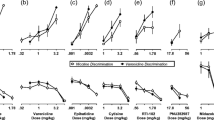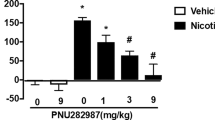Abstract
Previous studies have established that ABT-418 [(S)-3-methyl-5-(1 methyl-2-pyrrolidinyl)isoxazole hydrochloride] is a novel neuronal nicotinic acetylcholine receptor (nAChR) ligand with cognitive enhancing and anxiolytic-like activity 3- to 10-fold more potent than (−)-nicotine in rodents. A series of experiments was conducted to determine the discriminative stimulus properties of ABT-418 in comparison with (−)-nicotine, and to determine the relative potencies of these compounds on ventral tegmental area (VTA) neurons. While rats were able to discriminate (−)-nicotine 1.9 µmol/kg in 39 days, they were not able to discriminate 1.9 or 6.2 µmol/kg ABT-418 from a saline solution during 50 days of training. In rats trained to discriminate 1.9 µmol/kg (−)-nicotine, a reduced generalization was induced by ABT-418 at 1.9 and 6.2 µmol/kg, an effect completely blocked by the cholinergic channel blocker mecamylamine (15 µmol/kg, IP). However, in extensively trained rats, intraperitoneal or subcutaneous injections of ABT-418 induced 78–82% generalization at the 6.2 µmol/kg dose. The predominant metabolites of (−)-nicotine and ABT-418 (cotinine and A-87770, respectively) were devoid of any effect in nicotine-trained rats. The reduced potency of ABT-418 in nicotine-trained rats is consistent with the electrophysiological findings showing that ABT-418 is 3-fold less potent than (−)-nicotine in activating dopamine-containing neurons in the VTA area.
Similar content being viewed by others
References
Anderson DJ, Arneric SP (1994) Nicotinic receptor binding of [3H]cytisine, [3H]nicotine and [3H]methylcarbamylcholine in rat brain. Eur J Pharmacol 253:261–267
Apud JA (1993) The 5-HT3 receptor in mammalian brain: a new target for the development of psychotropic drugs. Neuropsychopharmacology 8:117–130
Arneric SP, Sullivan JP, Briggs CA, Donnelly-Roberts D, Anderson DJ, Raszkiewicz JL, Hughes M, Cadman ED, Adams P, Garvey DS, Wasicak J, Williams M (1994) ABT 418: a novel cholinergic ligand with cognition enhancing and anxiolytic activities: I. In vitro characterization. J Pharmacol Exp Ther 270:310–318
Betz H (1990) Ligand-gated ion channels in the brain: the amino acid receptor superfamily. Neuron 5:383–392
Brioni JD, Kim DJB, O'Neill AB, Williams JEG, Decker MW (1994a) Clozapine attenuates the discriminative stimulus properties of (−)-nicotine. Brain Res 643:1–9
Brioni JD, O'Neill AB, Kim DJB, Decker MW, Arneric SP (1994b) Anxiolytic-like effects of the novel cholinergic channel activator ABT 418. J Pharmacol Exp Ther 271:353–361
Brodie MS (1991) Low concentrations of nicotine increase the firing rate of neurons of the ventral tegmental area “in vitro”. In: Adlkofer F, Thurau K (eds) Advances in pharmacological sciences: effects of nicotine on biological systems. (Birkhauser Verlag, Basel/Boston, pp 373–377
Brodie MS, Shefner SA, Dunwiddle TV (1990) Ethanol increases the firing rate of dopamine neurons of the rat ventral tegmental area in vitro. Brain Res 508:65–69
Calabresi P, Lacey MG, North RA (1989) Nicotinic excitation of rat ventral tegmental neurons in vitro studied by intracellular recording. Br J Pharmacol 98:135–140
Clarke PBS (1994) Nicotine dependence — mechanisms and therapeutic strategies. Biochem Soc Symp 59:83–95
Clarke PBS, Schwartz RD, Paul SM, Pert CB, Pert A (1985) Nicotinic binding in rat brain: autoradiographic comparison of [3H]-acetylcholine, [3H]-nicotine and [125I]-α-bungarotoxin. J Neurosci 5:1307–1315
Decker MW, Brioni JD, Sullivan JP, Buckley MJ, Radek RJ, Raskiewickz JL, Kang CH, Kim DJB, Giardina WJ, Williams M, Arneric SP (1994) ABT 418: a novel cholinergic ligand with cognition enhancing and anxiolytic activities: II. In vivo characterization. J Pharmacol Exp Ther 270:319–328
Decker M, Brioni J, Bannon A, Arneric S (1995) Diversity of neuronal nicotinic acetylcholine receptors: lessons from behavior and implications for CNS therapeutics. Life Sci 56:545–570
Deneris ES, Connolly J, Rogers SW, Duvoisin R (1991) Pharmacological and functional diversity of neuronal nicotinic acetylcholine receptors. Trends Pharmacol Sci 12:34–40
DiChiara G, Imperato A (1988) Drugs abused by humans preferentially increase synaptic dopamine concentrations in the mesolimbic dopamine system of freely moving rats. Proc Natl Acad Sci USA 85:5274–5278
Flores CM, Rogers SW, Pabreza LA, Wolfe BB, Kellar KJ (1992) A subtype of nicotinic cholinergic receptor in rat brain is composed of α4 andβ 2 subunits and is up-regulated by chronic nicotine treatment. Mol Pharmacol 41:31–37
Garvey DS, Wasicak J, Decker MW, Brioni JD, Sullivan JP, Carrera GM, Holladay MH, Arneric SP, Williams M (1994) Novel isoxazoles which interact with brain cholinergic channel receptors that have intrinsic cognitive enhancing and anxiolytic activities. J Med Chem 37:1055–1059
Gessa GL, Muntoni F, Collu M, Vargiu L, Mereu G (1985) Low doses of ethanol activate dopaminergic neurons in the ventral tegmental area. Brain Res 348:201–203
Grace AA, Bunney BS (1983) Intracellular and extracellular electrophysiology of nigral dopaminergic neurons 1. Identification and characterization. Neuroscience 10:301–315
Grady S, Marks MJ, Wonnacott S, Collins AC (1992) Characterization of nicotinic receptor-mediated [3H]-dopamine release from synaptosomes prepared from mouse striatum. J Neurochem 59:848–856
Gysling K, Wang RY (1983) Morphine-induced activation of A10 dopamine neurons in the rat. Brain Res 277:119–127
Hirschhorn I, Rosecrans J (1974) Studies on the time course and the effect of cholinergic and adrenergic receptor blockers on the stimulus effect of nicotine. Psychopharmacologia 40:109–120
Imperato A, Mulas A, DiChiara C (1986) Nicotine preferentially stimulates dopamine release in the limbic system of freely moving rats. Eur J Pharmacol 132:337–338
Jacob P, Benowitz N, Shulgin A (1988) Recent studies of nicotine metabolism in humans. Pharmacol Biochem Behav 30:249–253
Kumar R, Reavill C, Stolerman I (1987) Nicotine cue in rats: effects of central administration of ganglion-blocking drugs. Br J Pharmacol 90:239–246
Lacey MG, Mercury NB, North RA (1989) Two cells types in rat substantia nigra zona compacta distinguished by membrane properties and actions of dopamine and opiods. J Neurosci 9:1233–1241
Luetje C, Patrick J (1991) Bothα- andβ-subunits contribute to the agonist sensitivity of neuronal nicotinic acetylcholine receptors. J Neurosci 11:837–845
Luetje C, Patrick J, Seguela P (1990a) Nicotine receptors in the mammalian brain. FASEB J 4:2753–2760
Luetje CW, Wada K, Rogers S, Abramson S, Tsuji K, Heinemann S, Patrick J (1990b) Neurotoxins distinguish between different neuronal nicotinic acetylcholine receptor subunit combinations. J Neurochem 55:632–640
Marks MJ, Farnham DA, Grady SR, Collins AC (1993) Nicotinic receptor function determined by stimulation of rubidium efflux from mouse synatosomes. J Pharmacol Exp Ther 264:542–552
Marks MJ, Stitzel JA, Romm E, Wehner JM, Collins AC (1986) Nicotinic binding sitesin rat and mouse brain: comparison of acetylcholine, nicotine, andα-bungarotoxin. Mol Pharmacol 30:427–436
Meltzer L, Rosecrans J, Aceto M, Harris L (1980) Discriminative stimulus properties of the optical isomers of nicotine. Psychopharmacology 68:283–286
Mueller AL, Brodie MS (1989) Intracellular recording from putative dopamine containing neurons in the ventral tegmental area of Tsai in a brain slice preparation. J Neurosci Meth 28:16–22
Petersen D, Norris K, Thompson J (1984) A comparative study of the disposition of nicotine and its metabolites in three inbred strains of mice. Drug Metab Dispos 12:725–731
Pratt J, Stolerman I, Garcha H, Giardini V, Feyerabend C (1983) Discriminative stimulus properties of nicotine: further evidence for mediation at a cholinergic receptor. Psychopharmacology 81:54–60
Reavill C, Stolerman IP (1987) Interaction of nicotine with dopaminergic mechanisms assessed through drug discrimination and rotational behaviour in rats. J Psychopharmacol 1:264–273
Reavill C, Walther B, Stolerman I, Testa B (1990) Behavioural and pharmacokinetic studies on nicotine, cytisine and lobeline. Neuropharmacology 29:619–624
Rodrigues D, Ferrero JL, Amman MT, Rotert GA, Cepa SP (1994) The in vitro hepatic metabolism of ABT-418, a cholinergic channel activator, in rat, dog, cynomolgus monkeys and human. Drug Metab Dispos 22:788–798
Romano C, Goldstein A, Jewell N (1981) Characterization of the receptor mediating the nicotine discriminative stimulus. Psychopharmacology 74:310–315
Rosecrans JA, Chance WT (1977) Cholinergic and non-cholinergic aspects of the discriminative stimulus properties of nicotine. In: Lal H (ed) Discriminative stimulus properties of drugs. Plenum Press, New York, pp 155–185
Sargent PB (1993) The diversity of neuronal nicotinic acetylcholine receptors. Annu Rev Neurosci 16:403–443
Schechter M, Rosecrans J (1972) Nicotine as a discriminative cue in rats: inability of related drugs to produce the nicotine-like cueing effect. Psychopharmacologia 27:379–387
Schulz D, Loring R, Aizenman E, Zigmond R (1991) Autoradiographic localization of putative nicotinic receptors in the rat brain using [125I]neuronal bungarotoxin. J Neurosci 11:287–297
Sebree T, Grebb JA, Kittle C, Kashkin KB (1993) A phase I, single, rising-dose study of A-81418, a novel cholinergic channel activator (ChCA) In: American College of Neuropsychopharmacology, 32nd Annual Meeting, Hawaii, p 201
Spencer DG, Emmett-Oglesby MW (1985) Parallel processing strategies in the application of microcomputers to the behavioral laboratory. Behav Res Methods Instr 17:294–300
Stolerman IP, Pratt JA, Garcha HS, Giardini V, Kumar R (1983) Nicotine cue in rats analyzed with drugs acting on cholinergic and 5-hydroxytryptamine mechanisms. Neuropharmacology 22:1029–1037
Stolerman I, Garcha H, Pratt J, Kumar R (1984) Role of training dose in dicrimination of nicotine and related compounds by rats. Psychopharmacology 84:413–419
Stolerman IP, Albuquerque EX, Garcha HS (1992) Behavioural effects of anatoxin, a potent nicotinic agonist, in rats. Neuropharmacology 31:311–314
Stroud RM, McCarthy MP, Shuster M (1990) Nicotinic acetylcholine receptor superfamily of ligand-gated channels. Biochemistry 29:11009–11023
Wise RA (1987) The role of reward pathways in the development of drug dependence. Pharmacol Ther 35:227–263
Author information
Authors and Affiliations
Rights and permissions
About this article
Cite this article
Brioni, J.D., Kim, D.J.B., Brodie, M.S. et al. ABT-418: discriminative stimulus properties and effect on ventral tegmental cell activity. Psychopharmacology 119, 368–375 (1995). https://doi.org/10.1007/BF02245851
Received:
Revised:
Issue Date:
DOI: https://doi.org/10.1007/BF02245851




